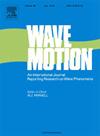Hybrid finite difference WENO schemes for the ten-moment Gaussian closure equations with source term
IF 2.5
3区 物理与天体物理
Q2 ACOUSTICS
引用次数: 0
Abstract
A hybrid weighted essentially non-oscillatory (WENO) finite difference scheme is proposed for computing discontinuous solutions of the ten-moment Gaussian closure equations. A salient feature of the proposed scheme is the use of low-cost component-wise reconstruction of the numerical fluxes in smooth regions and non-oscillatory characteristic-wise reconstruction in the vicinity of discontinuities. A troubled-cell indicator which measures the smoothness of the solution, and built on utilising the smoothness indicators of the underlying WENO scheme, is employed to effectively switch between the two reconstructions. The resulting hybrid WENO scheme is simple and efficient, is independent of the order and type of the WENO reconstruction, and it can be used as an effective platform to construct finite difference schemes of any arbitrary high-order accuracy. For demonstration, we have considered the fifth order WENO-Z reconstruction. We have performed several 1D and 2D numerical experiments to illustrate the efficiency of the proposed hybrid algorithm and its performance compared to the standard WENO-Z scheme. Numerical case studies shows that the present algorithm achieves fifth order accuracy for smooth problems, resolves discontinuities in a non-oscillatory manner and takes 25%–50% less computational time than the WENO-Z scheme while retaining many of its advantages.
带源项的十矩高斯闭包方程的混合有限差分WENO格式
提出了一种计算十矩高斯闭包方程不连续解的混合加权基本非振荡有限差分格式。该方案的一个显著特点是在光滑区域使用低成本的分量重建数值通量,在不连续区域附近使用非振荡特征重建。一个故障单元指示器用来测量解决方案的平滑性,并建立在利用底层WENO方案的平滑性指标的基础上,用于有效地在两个重建之间切换。所得到的混合WENO格式简单高效,与WENO重构的阶数和类型无关,可作为构建任意高阶精度有限差分格式的有效平台。为了证明这一点,我们考虑了五阶WENO-Z重建。我们进行了几个一维和二维数值实验,以说明所提出的混合算法的效率及其与标准WENO-Z方案的性能比较。数值算例研究表明,该算法对光滑问题达到五阶精度,以非振荡方式解决不连续问题,计算时间比WENO-Z格式减少25%-50%,同时保留了WENO-Z格式的许多优点。
本文章由计算机程序翻译,如有差异,请以英文原文为准。
求助全文
约1分钟内获得全文
求助全文
来源期刊

Wave Motion
物理-力学
CiteScore
4.10
自引率
8.30%
发文量
118
审稿时长
3 months
期刊介绍:
Wave Motion is devoted to the cross fertilization of ideas, and to stimulating interaction between workers in various research areas in which wave propagation phenomena play a dominant role. The description and analysis of wave propagation phenomena provides a unifying thread connecting diverse areas of engineering and the physical sciences such as acoustics, optics, geophysics, seismology, electromagnetic theory, solid and fluid mechanics.
The journal publishes papers on analytical, numerical and experimental methods. Papers that address fundamentally new topics in wave phenomena or develop wave propagation methods for solving direct and inverse problems are of interest to the journal.
 求助内容:
求助内容: 应助结果提醒方式:
应助结果提醒方式:


